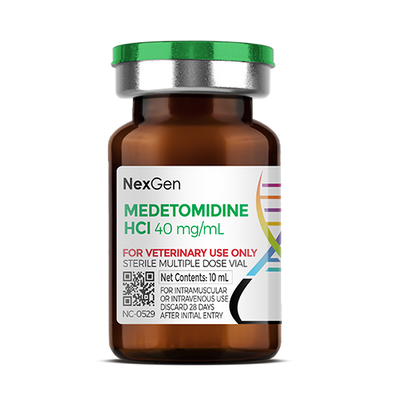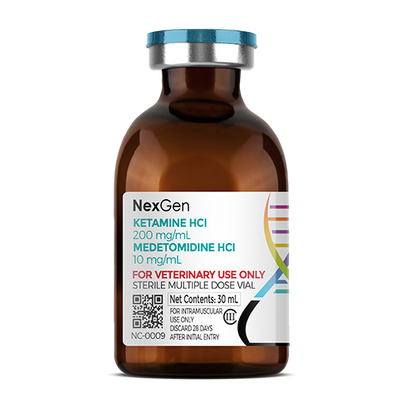
Medetomidine HCl 10 mg/mL, Injectable, (10mL)
Login for pricing
- Brand
- Mixlab
- SKU:
- NC-0263
- Product Type:
- Injectable
- Administration:
- Intramuscular
- Size:
- 10ml
Many procedures that are routinely accomplished in domestic animals with minimal restraint require anesthesia for the welfare and safety of both the zoo animal and veterinarian. Therefore, the chemical immobilization of wild and exotic animals in the zoo setting (as opposed to in the field) is essentially a form of veterinary anesthesia conducted under substantially more difficult circumstances than in a practice setting.1
Situationally, the chemical immobilization of zoo animals involves far more control and predictability of the environment than sedating or anesthetizing the same animals in the field, but it still requires an abundance of caution and planning, as well as the requisite skills and qualified personnel. Although physiological responses during the maintenance of anesthesia are not different in a given species in the zoo (versus in the field), successful induction and recovery require significantly more knowledge and skills.2
While veterinarians in traditional practice settings are typically very well-versed in the action of commonly-used anesthetics and the physiological responses of familiar domesticated species, it can be an ongoing challenge for veterinarians to maintain stocks of the appropriate sedation and anesthetic drugs for animals in the zoo setting.
Medetomidine in the Zoo Setting
Medetomidine (medetomidine hydrochloride), used alone and in combination with other drugs, has been shown to be useful for anesthesia and immobilization in zoo animals.3 Medetomidine is an α-2-adrenoreceptor agonist with sedative and analgesic properties. It is used by veterinarians as both a surgical anesthetic and analgesic. The pharmacological restraint and pain relief provided by medetomidine facilitates handling and aids in the conduct of diagnostic or therapeutic procedures. It also facilitates minor surgical procedures (with or without local anesthesia) and dental care where intubation is not required.
Dosages
When using medetomidine in zoo, exotic and wildlife medicine refer to specific references, including:
a) Zoo Animal and Wildlife Immobilization and Anesthesia, 2nd ed. West, G., Heard, D., Caulkett, N. (eds.). Blackwell Publishing, 2014.
b) Handbook of Wildlife Chemical Immobilization, 3rd Ed. Kreeger, T.J. and J.M. Arnemo. 2007.
c) Fowler’s Zoo and Wild Animal Medicine Current Therapy, Volume 7, Miller, R.E., Fowler, M.E., Saunders. 2011.
d) Exotic Animal Formulary, 5th Ed. Carpenter, J.W., Saunders. 2017.
Where to buy Medetomidine 10mg/ml
Medetomidine 10mg/ml is available in the U.S. through several pharmaceutical manufacturers and through veterinary custom compounding companies.
FOR RX ONLY: A valid prescription from a licensed veterinarian is required for dispensing this medication.
1Nielsen L. Chemical immobilization of wild and exotic animals. Iowa: Iowa State University Press, 1999; 227-281.
2Lewis JCM. Anesthesia of non-domestic cats. Hall, L.W., Taylor, P.M. Anaesthesia of the Cat. London: Bailliere Tindall, 1994; 310-349.
3Vähä-Vahe T. The clinical efficacy of medetomidine. Acta Vet Scand Suppl. 1989;85:151-3. PMID: 2571266.
5Di Pietro S, et al. Effects of a medetomidine-ketamine combination on Schirmer tear test I results of clinically normal cats. Am J Vet Res. 2016;77(3):310-314.
6Kanda T, et al. Temporal effects of intramuscular administration of medetomidine hydrochloride or xylazine hydrochloride to healthy dogs on tear flow measured by use of a Schirmer tear test I. Am J Vet Res. 2016;77(4):346-350.
7Kanda T, et al. Effects of medetomidine and xylazine on intraocular pressure and pupil size in healthy Beagle dogs. Vet Anaesth Analg. 2015;42(6):623-628.
8Malmasi A, Ghaffari MS. Lack of effects of intramuscular medetomidine on intraocular pressure in clinically normal cats. J Feline Med Surg. 2016;18(4):315-317.
9Perotta JH, et al. Hyoscine-N-butylbromide premedication on cardiovascular variables of horses sedated with medetomidine. Vet Anaesth Analg. 2014;41(4):357-364.




















